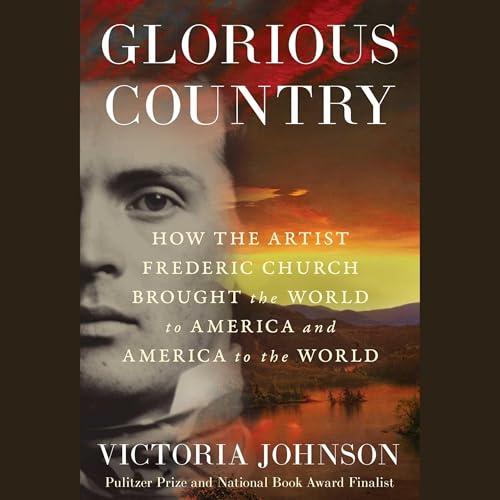
Glorious Country
How the Artist Frederic Church Brought the World to America and America to the World
No se pudo agregar al carrito
Solo puedes tener X títulos en el carrito para realizar el pago.
Add to Cart failed.
Por favor prueba de nuevo más tarde
Error al Agregar a Lista de Deseos.
Por favor prueba de nuevo más tarde
Error al eliminar de la lista de deseos.
Por favor prueba de nuevo más tarde
Error al añadir a tu biblioteca
Por favor intenta de nuevo
Error al seguir el podcast
Intenta nuevamente
Error al dejar de seguir el podcast
Intenta nuevamente
$0.00 por los primeros 30 días
POR TIEMPO LIMITADO
Obtén 3 meses por US$0.99 al mes
La oferta termina el 16 de diciembre de 2025 11:59pm PT.
 Exclusivo para miembros Prime: ¿Nuevo en Audible? Obtén 2 audiolibros gratis con tu prueba.
Exclusivo para miembros Prime: ¿Nuevo en Audible? Obtén 2 audiolibros gratis con tu prueba.
Solo US$0.99 al mes los primeros 3 meses de Audible.
1 bestseller o nuevo lanzamiento al mes, tuyo para siempre.
Escucha todo lo que quieras de entre miles de audiolibros, podcasts y Originals incluidos.
Se renueva automáticamente por US$14.95 al mes después de 3 meses. Cancela en cualquier momento.
Elige 1 audiolibro al mes de nuestra inigualable colección.
Escucha todo lo que quieras de entre miles de audiolibros, Originals y podcasts incluidos.
Accede a ofertas y descuentos exclusivos.
Premium Plus se renueva automáticamente por $14.95 al mes después de 30 días. Cancela en cualquier momento.
Haz tu pedido de preventa ahora por $21.55
-
Narrado por:
-
De:
-
Victoria Johnson
“They came to see the world.”
New York, spring 1859. Outside Frederic Church’s Tenth Street studio, men and women amassed by the thousands hoping for a glimpse of his magnificent Heart of the Andes: a painting whose sublime, ‘near supernatural’ rendering of the vast Andean landscape encountered on the artist’s recent travels introduced thousands of Americans to the fierce, majestic beauty of the far-flung wildernesses of the globe.
Frederic Church brought the world to America, and America into the world. Cementing the United States as a cultural and artistic force a full century before America’s Abstract Impressionists rose to prominence, Church’s bold paintings composed odes in color, shadow, and light to natural places near and far: the lush jungles of South America and immense icebergs of Newfoundland where he journeyed as a young man; the Syrian deserts and ancient, ruined cities where he and his wife traveled following the devastating loss of their two young children; the verdant, luminous valley around the Hudson where Church first studied painting and where he returned and established his estate, Olana, whose landscape itself became a work of art. Deeply influenced by the work of Alexander von Humboldt, Church conjured a vision of the natural world as a place of communion with creation.
Church charted, across the latter half of the 19th century, a career that both inhabited and gave shape to the artistic, cultural, and political crosscurrents of his day. Through a close examination of Church's letters, sketches, paintings, and diaries, and traveling in Church's footsteps to Egypt, the Andes, Petra, Jamaica, and Jerusalem, Johnson traces the path not only of one man’s life, but of a country swept up in an era of vast and vertiginous change. Church worked and lived in New York in the city’s formative years. He was a founder of its first great museum, the Met, and in paintings, not in words, he conveyed his passion for the exquisite natural beauty of the United States, but also for a Union free of slavery. He gave Americans visions of the majesty of their own new country and of the wonders of worlds only to be seen in paintings by this astonishing adventurer and artist. Church was a master artist and innovator, turning landscape painting into a portrait of a nation, and in the process, putting American art on the map of the world. Glorious Country is a book, Johnson writes, “about how we see and what we save.”
Todavía no hay opiniones



